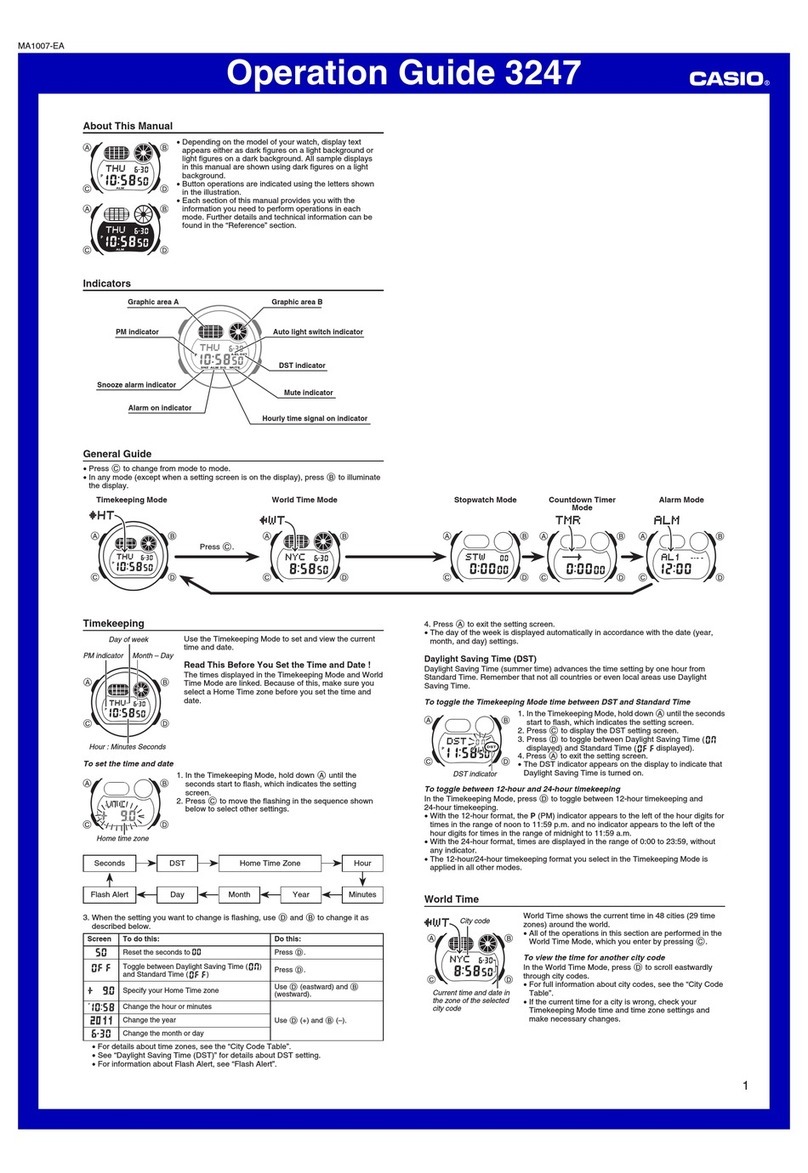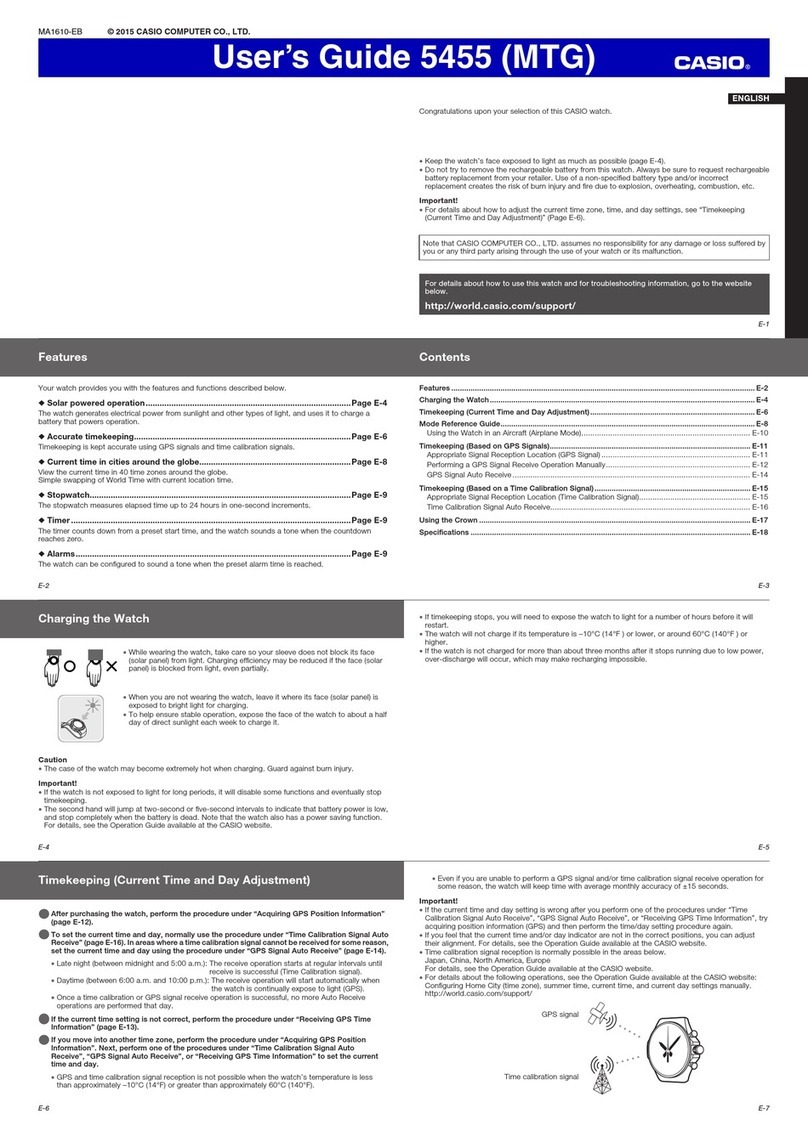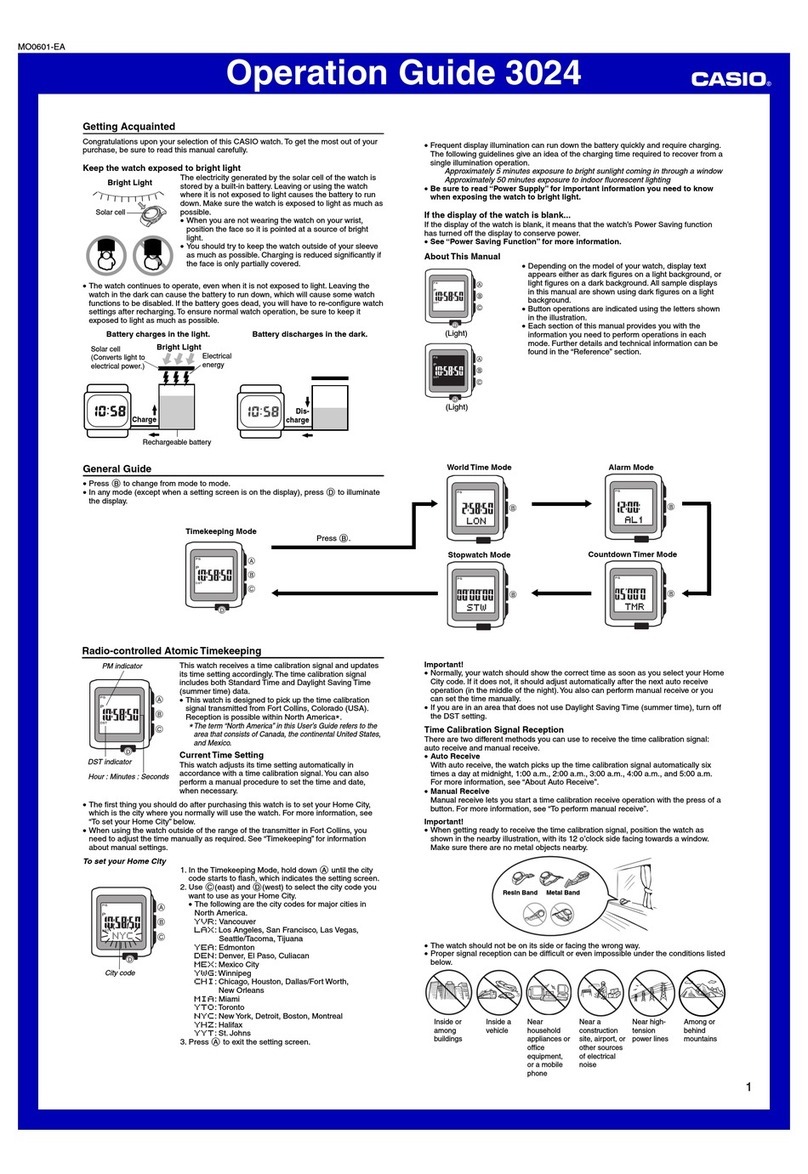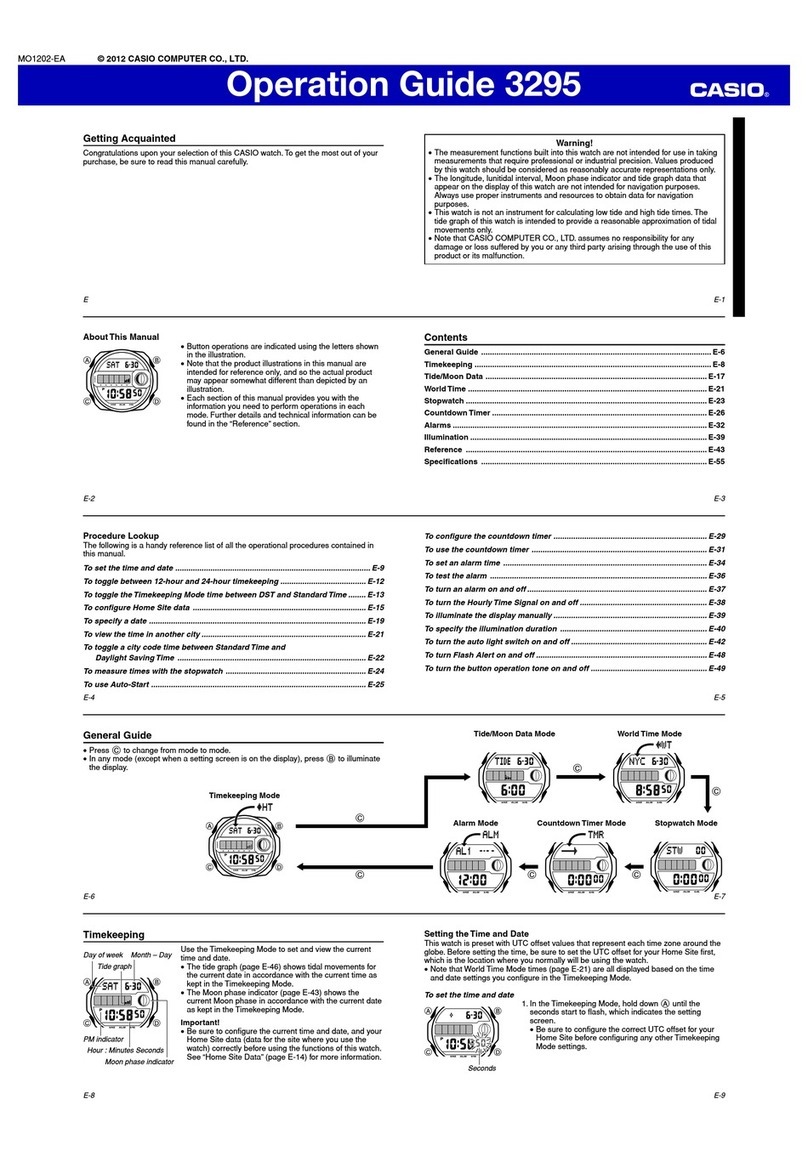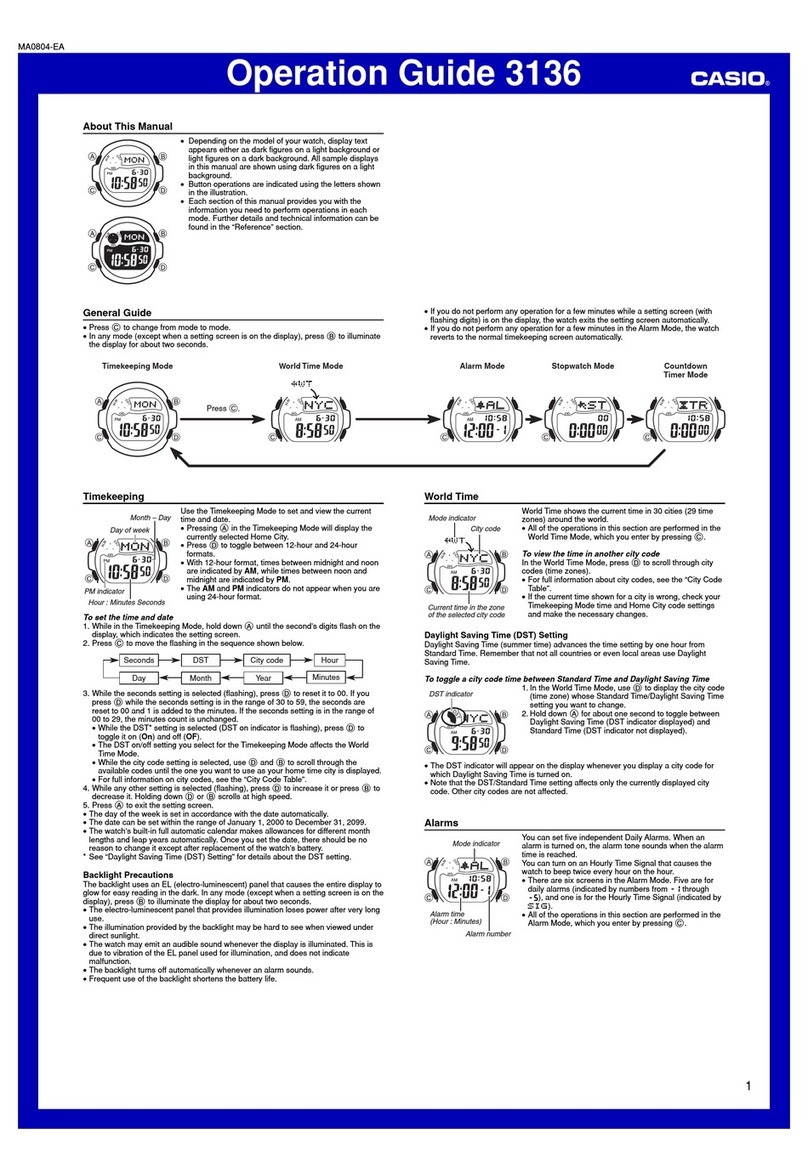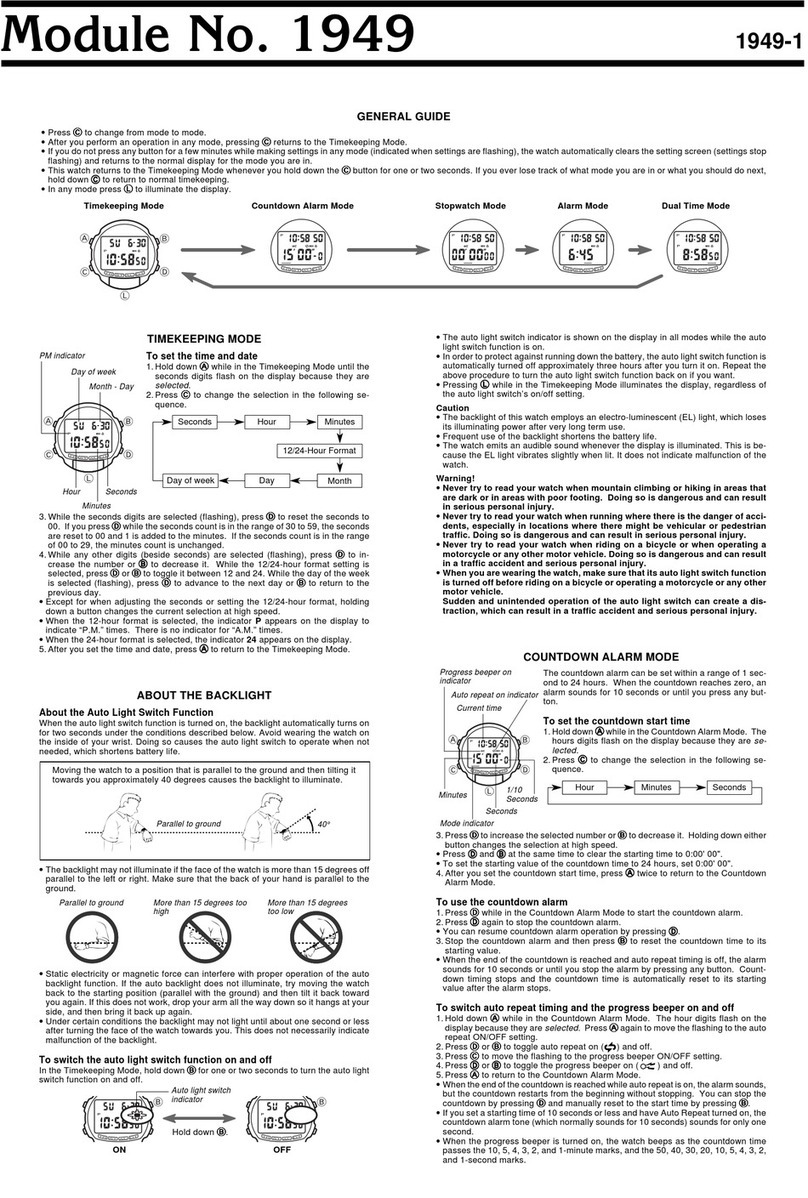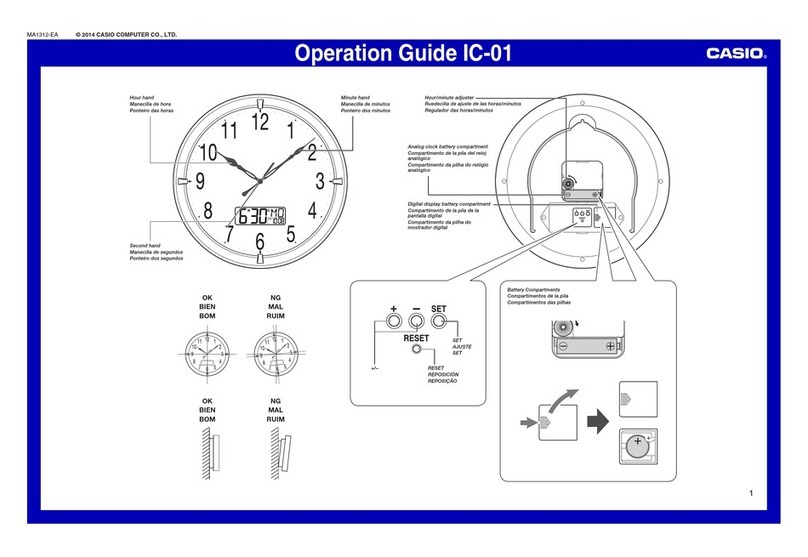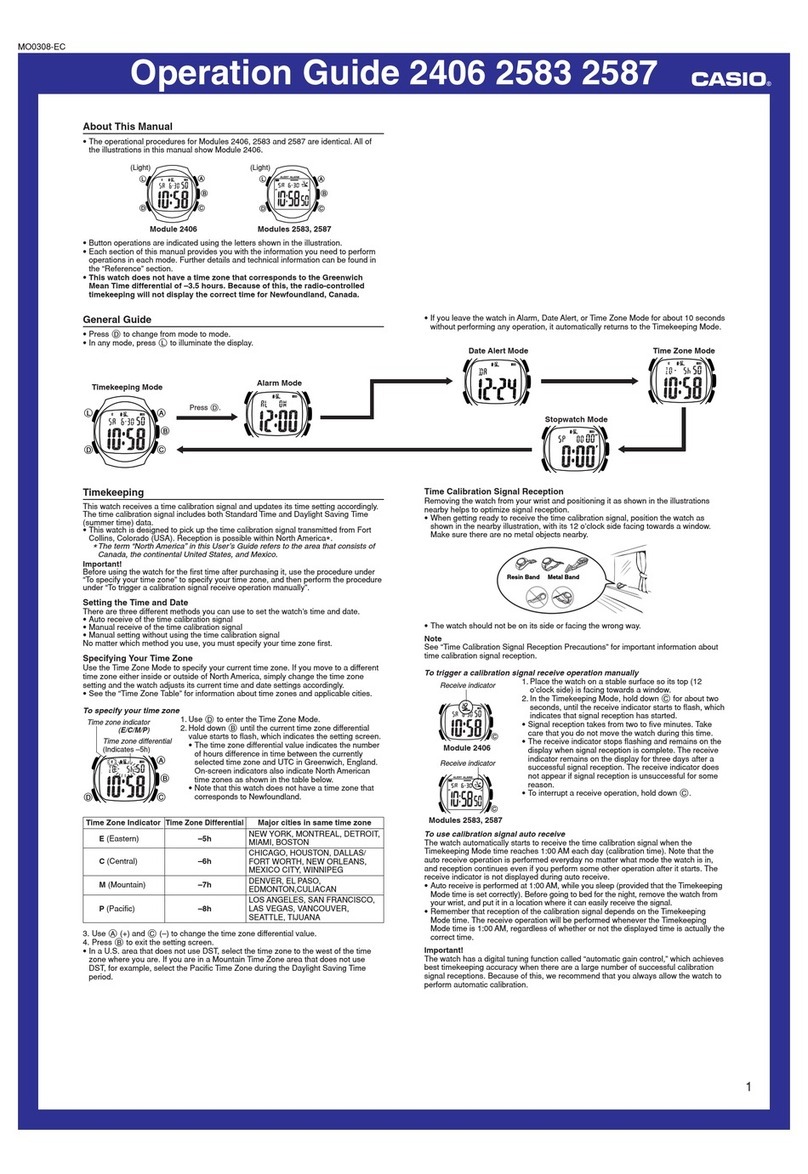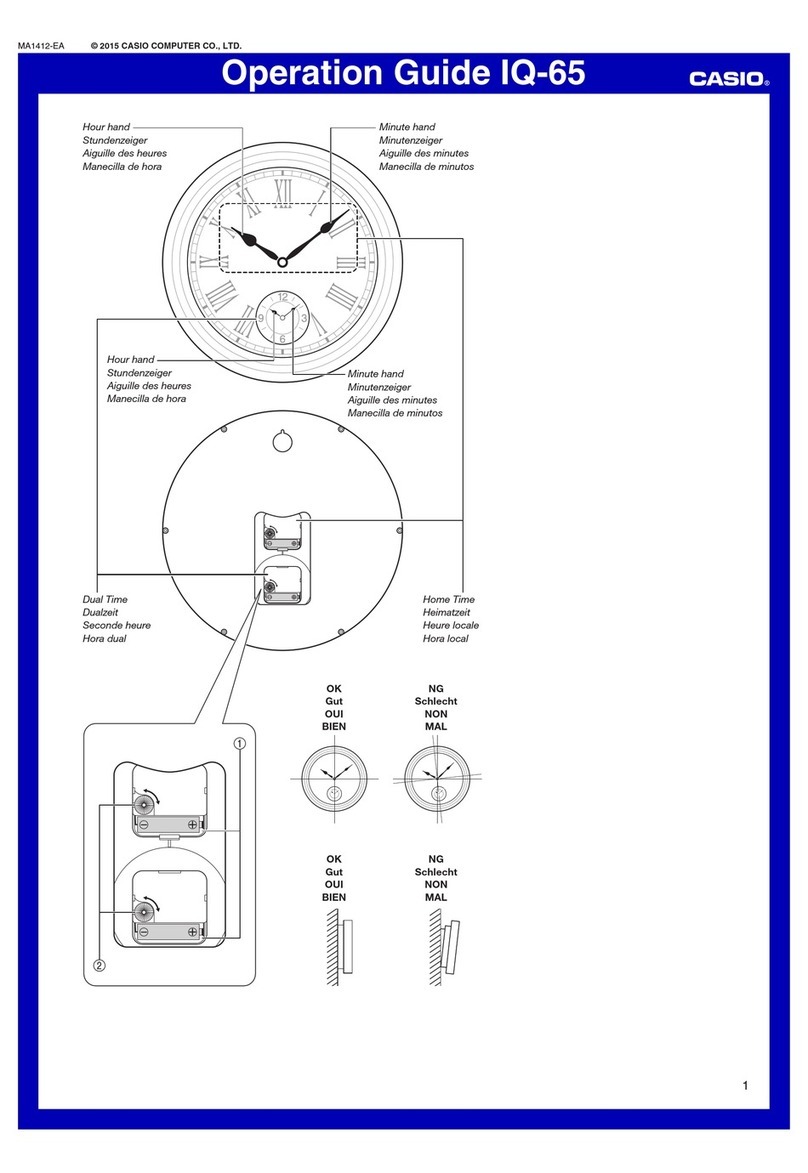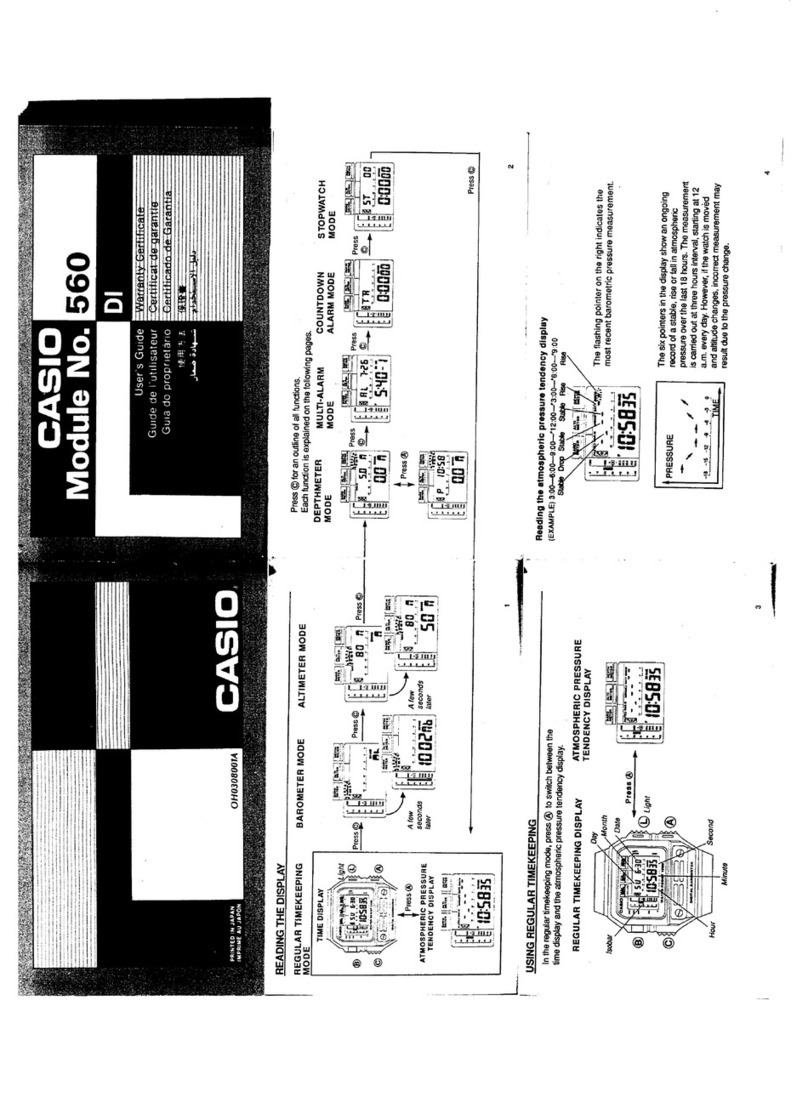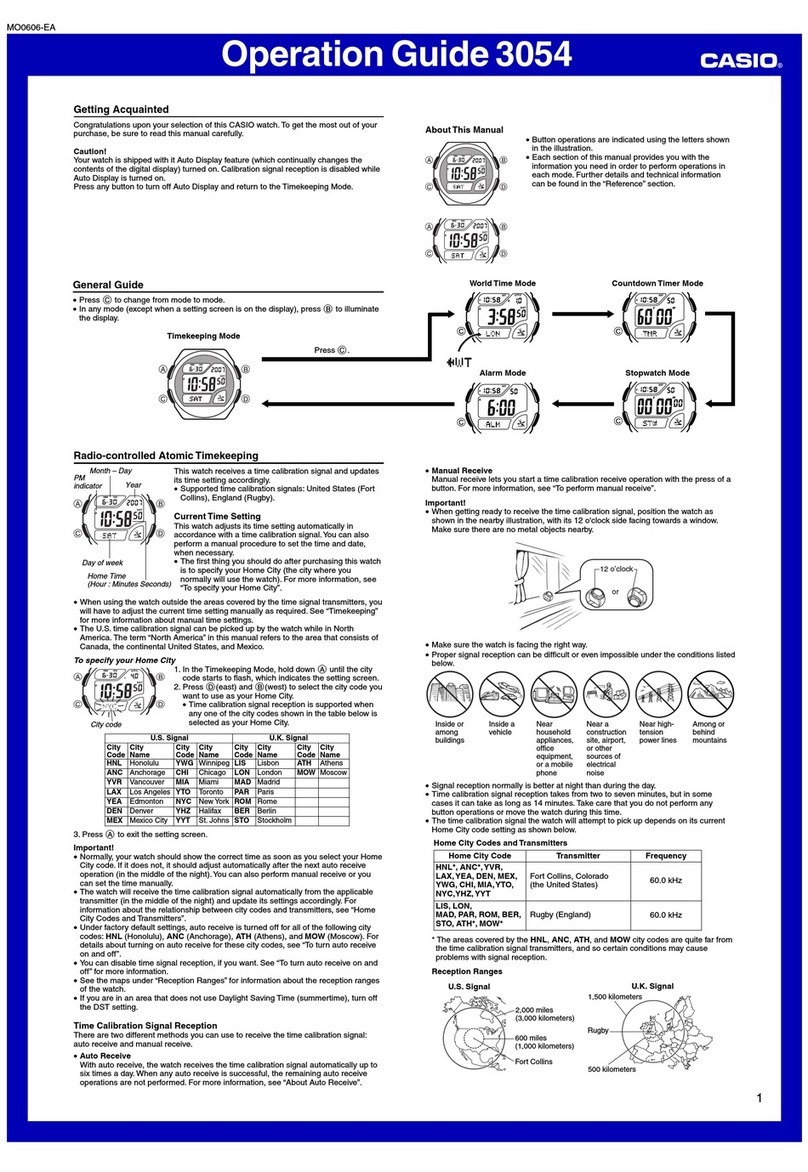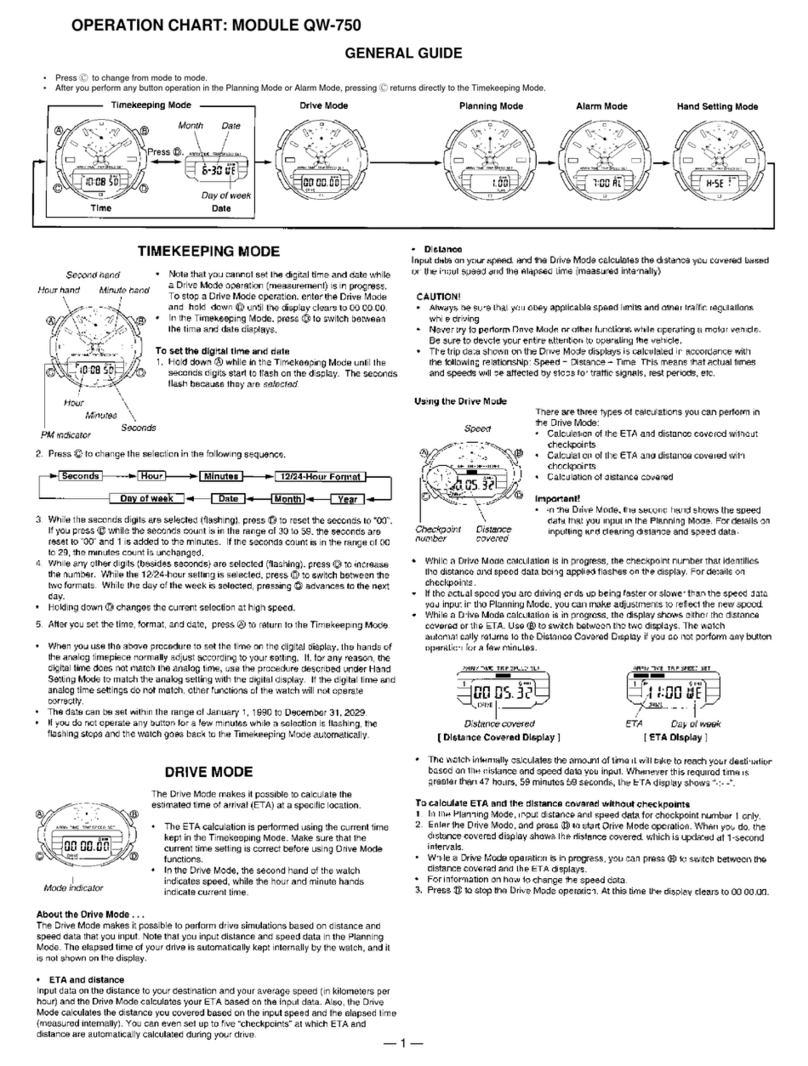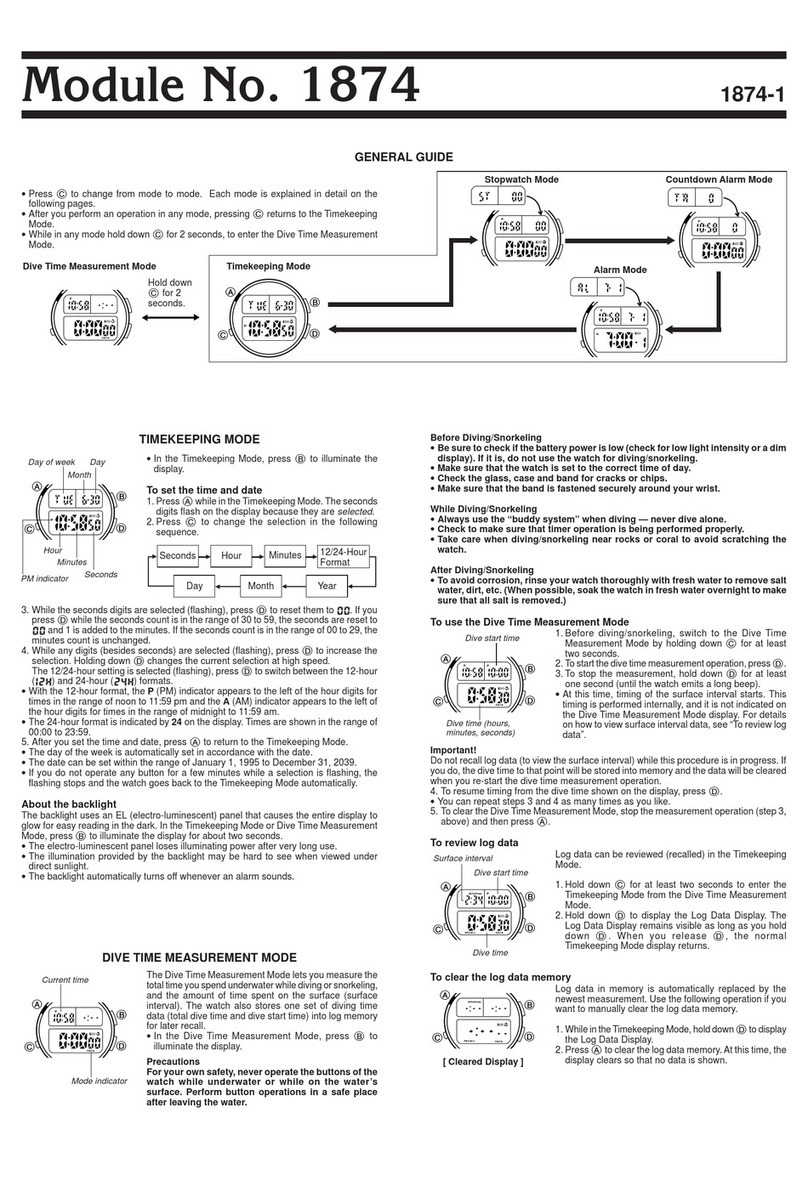
Operation Guide 4361
4
3. When the setting you want to change is flashing, use Band/or Dto change it as
described below.
Screen: To do this:
Change the city code
Cycle between Daylight Saving Time
(), Standard Time ( ), and Auto
DST ( )
Toggle between 12-hour (12H) and
24-hour (24H) timekeeping
Do this:
Use D(east) and B(west).
Press D.
Press D.
Reset the seconds to
Change the hour or minutes
Change the year
Change the month or day
Toggle Power Saving on ( ) and off
()
Press D.
Press B.
Use D(+) and B(–).
Press D.
•See “City Code Table”for a complete list of available city codes.
•Auto DST ( ) can be selected only while LIS, LON, BCN, MAD, PAR, MIL,
ROM, BER, STO, or ATH is selected as the Home City code. For more
information, see “Daylight Saving Time (DST)”below.
•For information about settings other than the time and date, see the following.
Power Saving: Power Saving Function
4. Press Ato exit the setting screen.
Daylight Saving Time (DST)
Daylight Saving Time (summer time) advances the time setting by one hour from
Standard Time. Remember that not all countries or even local areas use Daylight
Saving Time.
The time calibration signals transmitted from Mainflingen and Rugby includes both
Standard Time and DST data. When the Auto DST setting is turned on, the watch
switches between Standard Time and DST (summer time) automatically in
accordance with the Mainflingen and Rugby signals.
•The default DST setting is Auto DST ( ) whenever you select LON, PAR, BER,
or ATH as your Home City code.
•If you experience problems receiving the time calibration signal in your area, it is
probably best to switch between Standard Time and Daylight Saving Time (summer
time) manually.
To change the Daylight Saving Time (summer time) setting
1. In the Timekeeping Mode, hold down Auntil the city code starts to flash, which
indicates the setting screen.
2. Press Conce and the DST setting screen appears.
3. Use Dto cycle through the DST settings in the sequence shown below.
4. When the setting you want is selected, press Ato exit the setting screen.
•The DST indicator ( ) appears on the display to indicate that Daylight Saving Time
is turned on.
Auto DST ( ) DST off ( ) DST on ( )
Analog Timekeeping
The analog time of this watch is synchronized with the digital time. The analog time
setting is adjusted automatically whenever you change the digital time.
Note
•The hands for the analog timepiece move to adjust to a new setting whenever any of
the following occurs.
When you change the digital time setting manually
When the digital time setting is changed by time calibration signal reception
When you change the Home City code and/or DST setting
•If the analog time does not match the digital time for any reason, use the procedure
described under “To adjust the analog time”to match the analog setting to the digital
setting.
•Whenever you need to adjust both the digital and the analog time settings manually,
make sure you adjust the digital setting first.
•Depending on how much the hands have to move in order to adjust to the digital
time, it may take some time before they stop moving.
To adjust the analog time
1. In the Timekeeping Mode, press Cfive times to enter
the Hand Setting Mode.
2. Hold down Auntil the current digital time starts to
flash, which indicates the setting screen.
3. Use Dand Bto adjust the analog setting as
described below.
When you want to do this:
Move the hand setting
forward 20 seconds
Move the hand setting a short
way forward at high speed
Perform this button operation:
•Press D.
•Hold down D.
•Release Dwhen the hands reach the setting
you want.
|
|
|
|
|
|
|
|
|
|
Move the hand setting a long
way forward at high speed
•While holding down Dto move the hands at
high speed, press Bto lock the high-speed
hand movement.
•To stop the hand movement, press any
button.
•Hand movement stops automatically if the hour
hand makes one full (12-hour) revolution.
4. Press Ato exit the setting screen.
•The minute hand will be adjusted slightly to match the seconds when you exit the
setting screen.
•To return to the Timekeeping Mode, press C.
Power Supply
This watch is equipped with a solar cell and a special rechargeable battery (secondary
battery) that is charged by the electrical power produced by the solar cell. The
illustration shown below shows how you should position the watch for charging.
Example: Orient the watch so its face
is pointing at a light source.
•The illustration shows how to position
a watch with a resin band.
•Note that charging efficiency drops
when any part of the solar cell is
blocked by clothing, etc.
•You should try to keep the watch
outside of your sleeve as much as
possible. Charging is reduced
significantly if the face is only partially
covered.
Solar cell
Important!
•Storing the watch for long periods in an area where there is no light or wearing it in
such a way that it is blocked from exposure to light can cause rechargeable battery
power to run down. Make sure that the watch is normally exposed to bright light
whenever possible.
•This watch uses a special rechargeable battery to store power produced by the solar
cell, so regular battery replacement is not required. However, after very long use, the
rechargeable battery may lose its ability to achieve a full charge. If you experience
problems getting the special rechargeable battery to charge fully, contact your dealer
or CASIO distributor about having it replaced.
•Never try to remove or replace the watch’s special battery yourself. Use of the wrong
type of battery can damage the watch.
•The current time and all other settings return to their initial factory defaults whenever
battery power drops to Level 5 and when you have the battery replaced.
•Turn on the watch’s Power Saving function and keep it in an area normally exposed
to bright light when storing it for long periods. This helps to keep the rechargeable
battery from going dead.
Battery Power Indicator and Recover Indicator
The battery power indicator shows you the current power level of the rechargeable
battery.
Battery power indicator
Recover indicator
Function Status
All functions enabled.
All functions enabled.
Alarm, hourly time signal
and illumination disabled.
All functions disabled.
Display disabled and
initialized.
Level
1
2
3
4
5
Battery Power Indicator
(Charge Soon Alert)
|
|
|
|
|
|
|
|
|
|
|
|
|
|
|
|
(Charge Soon Alert)
•
The LOW indicator flashes on the display in the Timekeeping Mode when battery is at Level 3.
•The LOW indicator at Level 3 and the flashing charge indicator (CHG) at Level 4 tell
you that battery power is very low, and that exposure to bright light for charging is
required as soon as possible.
•At Level 5, all functions are disabled and settings return to their initial factory
defaults. Functions are enabled once again after the rechargeable battery is
charged, but you need to set the time and date, after the battery reaches Level 4
(indicated by the flashing charge indicator) from Level 5.You will not be able to
configure any of the other settings until the battery reaches Level 3 (no charge
indicator) after dropping to Level 5.
•
Leaving the watch in direct sunlight or some other very strong light source can cause the
battery power indicator to show a reading that is momentarily higher than the actual
battery level. The correct battery power indicator should appear after a few minutes.
•If you use the light or alarms a number of times during a short period, the recover
indicator ( ) appears and the following operations become disabled until battery
power recovers.
Illumination
Beeper tone
After some time, battery power will recover and the recover indicator will disappear,
indicating that the above functions are enabled again.
Charging Precautions
Certain charging conditions can cause the watch to become very hot. Avoid leaving
the watch in the areas described below whenever charging its rechargeable battery.
Also note that allowing the watch to become very hot can cause its liquid crystal
display to black out. The appearance of the LCD should become normal again when
the watch returns to a lower temperature.
Warning!
Leaving the watch in bright light to charge its rechargeable battery can cause it
to become quite hot. Take care when handling the watch to avoid burn injury.
The watch can become particularly hot when exposed to the following
conditions for long periods.
•On the dashboard of a car parked in direct sunlight
•Too close to an incandescent lamp
•Under direct sunlight
Charging Guide
After a full charge, timekeeping remains enabled for up to about 6 months.
•The following table shows the amount of time the watch needs to be exposed to light
each day in order to generate enough power for normal daily operations.
•Since these are the specs, we can include all the technical details.
•Display on 18 hours per day, sleep state 6 hours per day
•1 illumination operation (1.5 seconds) per day
•10 seconds of alarm operation per day
•16 minutes of signal reception per day
•Stable operation is promoted by frequent exposure to light.
Exposure Level (Brightness)
Outdoor Sunlight (50,000 lux)
Sunlight Through a Window (10,000 lux)
Daylight Through a Window on a Cloudy Day
(5,000 lux)
Indoor Fluorescent Lighting (500 lux)
Approximate Exposure Time
8 minutes
30 minutes
48 minutes
8 hours







